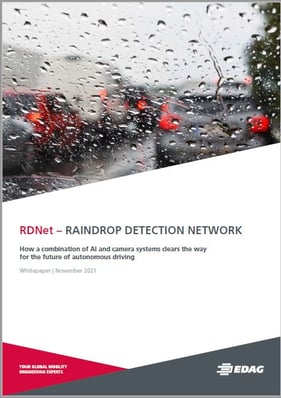Raindrop detection - an AI-based concept within the context of autonomous driving

Autonomous driving, the largest area of research in the automotive industry, is currently leading to a revolutionary change. Vehicles are learning to navigate autonomously in both controlled and uncontrolled environments. But without a suitable sensor set, it is almost impossible to develop systems that replicate or even surpass human driving behaviour. This is especially true for driving in adverse weather conditions such as rain or snow.
Of all the common sensors installed in an autonomous vehicle, the camera is the centrepiece. The camera lens is to the vehicle what the eyes are to humans: Through it, it "sees" its surroundings. The data received from the camera is further processed by a variety of algorithms to detect a wide range of obstructions on the road. This is important in order to make correct decisions and thus avoid collisions and accidents. The best-known camera-based systems include sign recognition, parking assist, pedestrian detection and lane departure warning.
For a system to be able to act without human intervention, it must mimic human thinking. AI makes this possible. RDNet represents one of these solutions. How does the system work and how did EDAG develop the software? If you would like to find out the answers to these and many other questions regarding AI, Deep Learning and Computer Vision, then you should register now and download the free whitepaper by our AI software developer Malavika Venugopal "How a combination of AI and camera systems clears the way for the future of autonomous driving".
Download white paper now